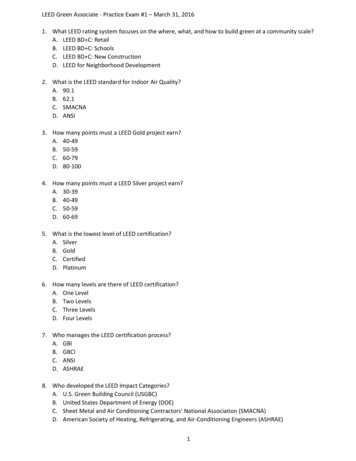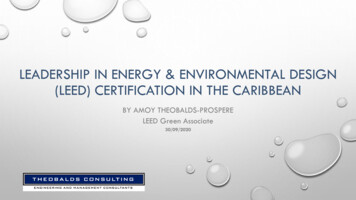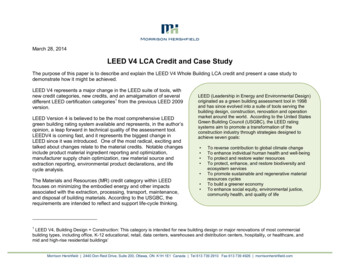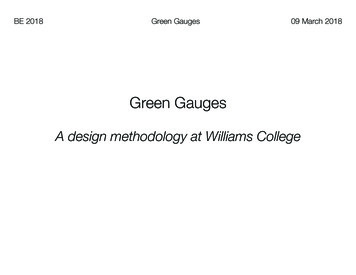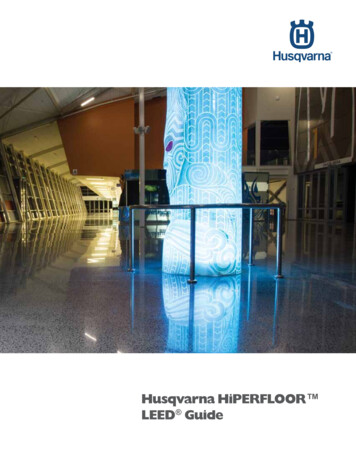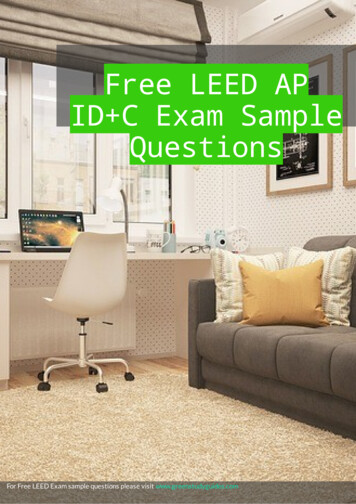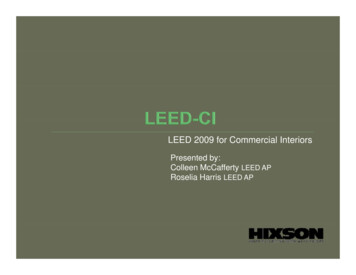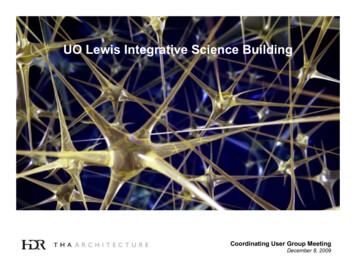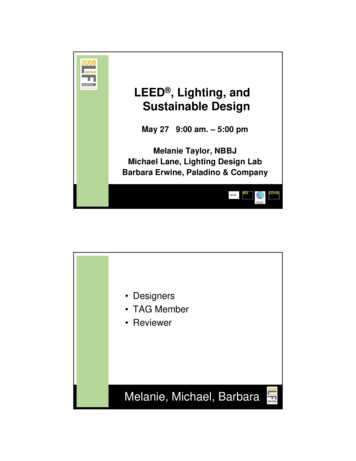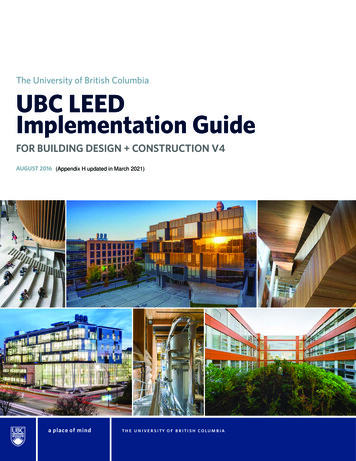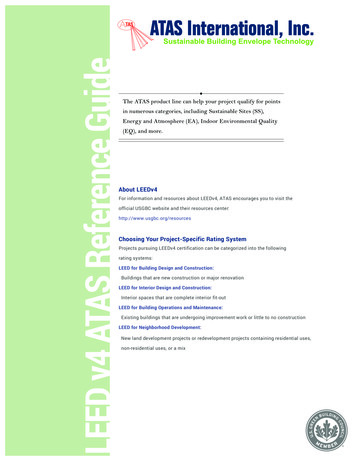
Transcription
LEED v4 ATAS Reference GuideThe ATAS product line can help your project qualify for pointsin numerous categories, including Sustainable Sites (SS),Energy and Atmosphere (EA), Indoor Environmental Quality(EQ), and more.About LEEDv4For information and resources about LEEDv4, ATAS encourages you to visit theofficial USGBC website and their resources center:http://www.usgbc.org/resourcesChoosing Your Project-Specific Rating SystemProjects pursuing LEEDv4 certification can be categorized into the followingrating systems:LEED for Building Design and Construction:Buildings that are new construction or major renovationLEED for Interior Design and Construction:Interior spaces that are complete interior fit-outLEED for Building Operations and Maintenance:Existing buildings that are undergoing improvement work or little to no constructionLEED for Neighborhood Development:New land development projects or redevelopment projects containing residential uses,non-residential uses, or a mix
ATAS Products & LEED Credits - GuideIPINTEGRATIVE PROCESS CATEGORYINTEGRATIVE PROCESS CREDIT 1 PTThe energy efficiency attributes of ATAS cool roofs, above sheathing ventilation,insulated metal panels, and/or single skin wall panel systems can be factored into theCool Roof Paint Pigmentenergy modeling analysis during the integrative process. This credit can also be appliedto InSpire solar air heating panels when assessing thermal comfort.SSSUSTAINABLE SITES CATEGORYHEAT ISLAND REDUCTION CREDIT UP TO 2 PTSCool pigment paint reflects infrared radiation, keeping the material cooler and reducingurban heat island effect. Many ATAS roofing products are ENERGY STAR qualified,and comply with the stringent California Title 24 Energy Efficiency Standards. A numberof ATAS roof systems can be combined with an above sheathing ventilation strategy tofurther reduce cooling loads and air conditioning appliance usage (a secondaryAbove Sheathing Ventilationcontributor to urban heat island effect).RAIN WATER MANAGEMENT CREDIT UP TO 3 PTSA rainwater harvesting system integrated into an ATAS roof system will help to managerainwater on-site. Techniques used to harvest or divert rainwater allow for storm waterto be used on-site, and decrease the negative impacts of storm water run off and soilerosion. Metal roofs are an ideal choice for rainwater harvesting applications becausemetal roofs tend to have lower concentrations of bacteria as compared to other roofingmaterials. Rainwater harvesting systems can help a LEED registered building project toqualify for the points in this credit.Above Sheathing VentilationWESpacer ShimWATER EFFICIENCY CATEGORYOUTDOOR WATER USE REDUCTION CREDIT UP TO 2 PTSRainwater harvesting with an ATAS roof system can be used for landscape irrigation(see option 2: Reduced irrigation). A 2011 study published in the journal “WaterResearch” concluded that water captured from metal roofs has lower levels of dissolvedcarbon and carries less bacteria (e.g., coliform) than water collected from other roofingA 2011 study published in thejournal “Water Research”concluded that water capturedfrom metal roofs has lowerlevels of dissolved carbonsurfaces.and carries less bacteria (e.g.,INDOOR WATER USE REDUCTION CREDIT UP TO 6 PTSTo reduce indoor water usage, an ATAS roofing system can be used for rainwaterharvesting, which can be integrated into the building’s graywater system.2coliform) than water collectedfrom other roofing surfaces.
EAENERGY AND ATMOSPHERE CATEGORYMINIMUM ENERGY PERFORMANCE PREREQUISITETo meet the prerequisite of the Energy and Atmosphere category, a number of ATASproducts can be used to help maximize energy efficiency, such as insulated metalIsoleren Insulated Metal Panelspanels, cool roof systems, and above sheathing ventilation.OPTIMIZE ENERGY PERFORMANCE CREDIT UP TO 18 PTSEnergy efficient cool metal roof and wall systems and insulated metal panels can helprealize many of the design elements that are key to reducing energy demand. Energyefficient building envelope systems, such as cool roofing help to reduce heat gain/loss,reduce peak energy demand, and improve energy performance of the building. Inwarmer climates, light colored reflective roofs can be used to reflect energy away fromthe building and reduce energy demand for internal cooling. Further, the high thermalSolar-ready Roof Systemsemittance of painted metal products means that solar energy that is absorbed into thebuilding space below the roof is quickly re-radiated at night.Additionally, InSpire solar air heating wall panels that preheat ventilation air using solarenergy can help to optimize a building’s energy performance.RENEWABLE ENERGY PRODUCTION CREDIT UP TO 3 PTSStanding seam metal roofs are the best choice for crystalline PV and thin film solarInSpire Solar Air Heatingpanels because, unlike other materials, metal offers the longest service life. Wheninstalling a crystalline system that typically is warranted for 25 years of powergeneration, a building owner is going to benefit from a roofing substrate that has agreater life expectancy than that of the solar panels. Standing-seam panels also providea natural platform for attaching crystalline systems without any roof penetrations.“Transpired collectorsprovide the most reliable,best performing, and lowestcost solar heating forAdditionally, highly reflective roofs help keep rooftop temperatures cool, which resultsin better performance from solar panels.Additionally, InSpire solar air heating systems can contribute renewable energy to helpachieve points for this credit.commercial and industrialbuildings available on themarket today.”- U.S. Department ofEnergyMRMATERIALS AND RESOURCES CATEGORYCONSTRUCTION AND DEMOLITION WASTE MANAGEMENTPLANNING PREREQUISITEThe recyclability attributes of ATAS metal roof and wall systems may help to qualify forthe Construction and Demolition Waste Management Planning prerequisite.3
BUILDING LIFE CYCLE IMPACT REDUCTION CREDIT UP TO 5 PTSAn industry-wide Life Cycle Assessment of the metal roof and wall cladding products“Metal roofs typically have aminimum of 25% recycled content.and processes, as well as the manufacturing process for insulated metal panels (IMP),This level of recycled content al-was conducted by Metal Construction Association. The life cycle inventory of thelows metal roofing to be routinelyenvironmental impact data from that LCA project can be used in a whole-building LCAincluded on listings for “green” andas required in credit.recycled content products. It is also100% recyclable when ultimatelyremoved as part of buildingBUILDING PRODUCT DISCLOSURE AND OPTIMIZATIONENVIRONMENTAL PRODUCT DECLARATIONS CREDIT UP TO 2 PTSATAS anticipates EPD availability for light gauge cold rolled pre-painted steelproducts before the end of 2019. EPD availability for pre-painted aluminum productswill also be pursued.renovation or demolition. Otherroofing materials are routinelyremoved and disposed of in alandfill, but metal roofing can berecycled in its entirety. Metals areexceptional building materials thatcan credibly claim both recycledcontent and recyclability byBUILDING PRODUCT DISCLOSURE AND OPTIMIZATIONrecognized definitions.”- SOURCING OF RAW MATERIALS CREDIT UP TO 2 PTSMetal Roofing AllianceSteel has a high recycled content, which can help to contribute to minimum thresholdsof recycled content of groupings of building materials used in a project.The USGBC has ruled on the use of industry-average recycled content of materials. Asof January 1, 2013, recycled content claims must now be “ specific to the installedproduct”, where the term ‘specific product’ refers to “a unique product distinguished bycolor, type, and/or location of manufacturer as identified to the consumer SKU or othermeans”. For the purposes of LEED, steel has a previously established industry averageof 25% post-consumer recycled content, which does not require documentation on a perproduct basis. It is, in essence, a default minimum value if a product-specific value isunavailable. In ATAS’ manufacturing process the recycled content of our steel productsis directly related to the recycled content of the steel coil we utilize. Therefore, thedefault recycled content for ATAS products utilizing standard steel is 25% postconsumer when calculating for LEED.1ATAS also uses aluminum coil. The post- consumer recycled content of the aluminumcoil must be documented by the aluminum mill source for compliance in LEEDv4.2When a certain recycled content is required by the customer, the material can besourced, however extended lead times and increased costs may be incurred. ATAS iscertified to ISO 9001:2008 with design and has complete traceability on all materialsused in the production of primary products.4ATAS Products and Recycled Content1. ATAS sources materials based onavailability and price.2. Recycled content varies from supplierto supplier and may range from 0 to 85%.
CONSTRUCTION AND DEMOLITION WASTEMANAGEMENT CREDIT UP TO 2 PTS“.metal panels may be recycledwhen their useful life ends aftermany years ofservice and they can contributeagain to a futureproducts’ recycled content.”ATAS roof or wall panel systems that are fully recyclable and used on a LEEDregistered project will contribute to the building project qualifying for this credit giventhe recyclability of the ATAS products. One of the primary goals of the credit is to divertconstruction and demolition waste from landfills. Segregating recyclable waste ordebris from metal panels on a construction site helps to divert that material fromlandfills.Metal Roofing AllianceEQINDOOR ENVIRONMENTAL QUALITY CATEGORYMINIMUM ACOUSTIC PERFORMANCE PREREQUISITELEED-School projects using ATAS insulated metal panels and/or perforated acousticalsuspended ceiling panels can benefit from their acoustic performance advantages intrying to meet the criteria for the Minimum Acoustic Performance prerequisite.ACOUSTIC PERFORMANCE CREDIT 1 PTATAS insulated metal panels can help the building project meet the LEED criteria forcomposite sound transmission class (STC) ratings. LEED registered projects can qualifyfor the points in this credit by using ATAS insulated metal panels and/or perforatedacoustical suspended ceiling panels.LOW EMITTING MATERIALS CREDIT UP TO 3 PTSATAS wall panel systems can help a LEED-registered project comply with this credit ifthe wet-applied sealants and adhesives meet the LEED criteria for VOC levels andAcoustical Ceiling Systemscontent for both exterior and interior applications. Products must be tested anddetermined compliant in accordance with California Department of Public Health(CDPH) Standard Method v1.1-2010 using the applicable exposure scenario. Alladhesives and sealants wet-applied on site must meet the applicable chemical contentrequirements of SCAQMD Rule 1168, July 1, 2005 Adhesive and Sealant Applications,as analyzed by the methods specified in Rule 1168. The provisions of SCAQMD Rule1168 do not apply to adhesives and sealants subject to state or federal consumerproduct VOC regulations. If a product cannot reasonably be tested as specified above,testing of VOC content must comply with ASTM D2369-10, ISO 11890 part 1, ASTMD6886-03, or ISO 11890-2.5
THERMAL COMFORT CREDIT 1 PTBased on the excellent thermal performance of insulated metal panels, ATAS wall and/or roof systems can be designed to meet any of the above-mentioned standards andcan help a LEED-registered project to qualify for this credit.The ATAS InSpire wall should be considered as an HVAC accompaniment when thermalcomfort, energy costs and indoor air quality are being assessd. The InSpire transpiredsolar collector generates solar-heated air, which is tied into the building’s HVAC,supplementing the existing heat sources with solar heated outside air and reducing therisk of sick building syndrome.ININNOVATION CATEGORYINNOVATION CREDIT 5 PTSIsoleren Insulated Metal PanelsIf a LEED registered project can go above and beyond the LEEDv4 requirements, thereare a number of ways in which points can be earned for meeting the Innovation Creditrequirements. ATAS insulated metal panels, InSpire wall panels, and metal roof panelsystems can be integrated into a building’s overall design to help qualify for points inthis credit, assuming the building’s design team utilizes ATAS products to surpass therequirements of various credit categories and /or innovative performance notspecifically addressed by LEED.RPREGIONAL PRIORITY CATEGORY“The InSpire wall has provento be the best money spent forLEED credits on this project.Its returns beat our othersustainable energy and efficiencytechnologies hands-down!”Brett GroutFacilities DirectorREGIONAL PRIORITY - SPECIFIC CREDITS UP TO 4 PTSThis credit is available for enhancing the ability of LEED project teams toJWO Transit CenterGreenfield, MAaddress critical environmental issues that may be particular to a locale.LEED V4 PROJECT CHECKLISTFor additional information and resources aboutLEEDv4, visit the official USGBC website andtheir resources center:http://www.usgbc.org/resources6LRD0819
LEED for Building Operations and Maintenance: Existing buildings that are undergoing improvement work or little to no construction LEED for Neighborhood Development: New land development projects or redevelopment projects containing residential uses, LEED v4 ATAS Reference Guide non-residential uses, or a mix
